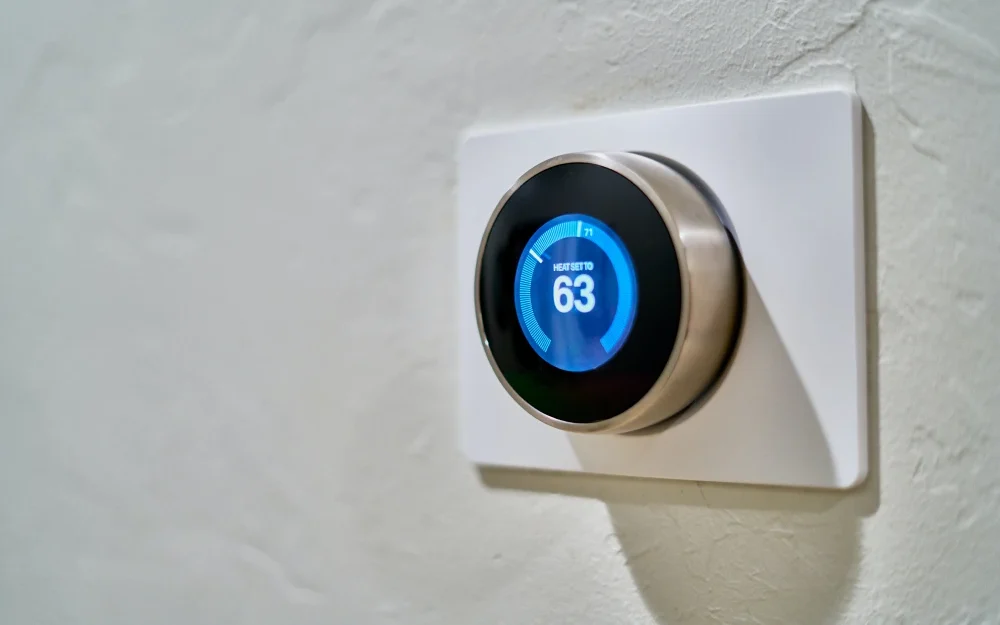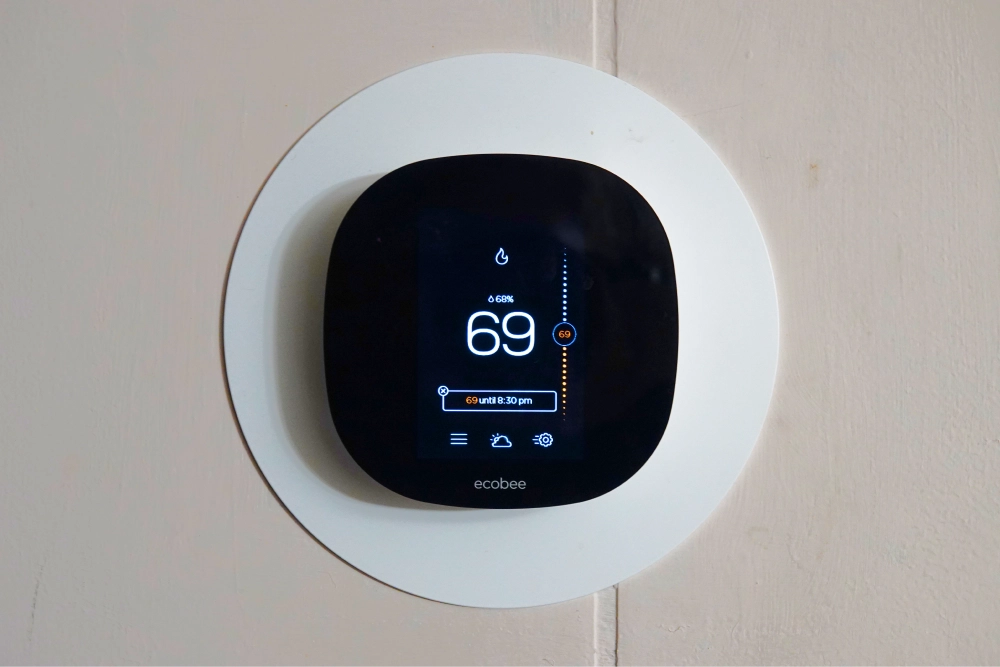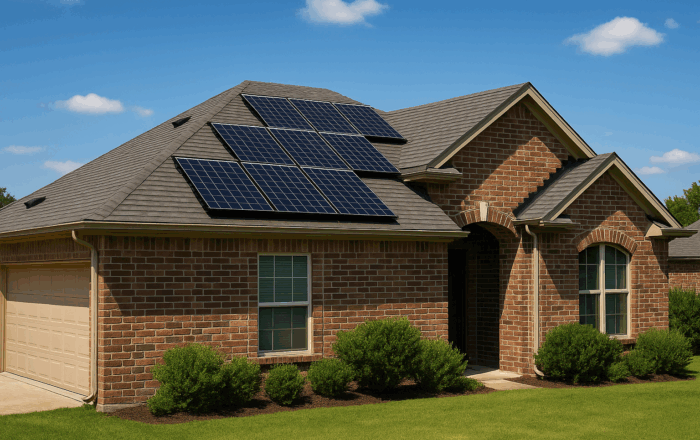Home Improvement Living in Texas
How Many Solar Panels Do You Need in Texas?
4 minute readHow to calculate the number of solar panels you need to power your Texas home
Home > BKV Energy Blog > All Posts > Can Smart Thermostats Save You Money on Your Electricity Bill?
Smart thermostats can cut energy bills by around 8%, saving homeowners approximately $50 per year through more efficient, automated temperature control.
8 minute read • Last update July 2025

The smart thermostat stands as a beacon of efficiency, convenience, and innovative technology. These devices have proven to be more than just a fancy way to control your home’s temperature, they represent a shift towards a more conscious and efficient use of energy.
Homeowners can make the most of this technology to not only achieve a more comfortable living environment but also save on their energy bills. Whether you’re new to the concept or a tech-savvy homeowner looking to upgrade, there’s no doubt that investing in a smart thermostat is a step towards a more efficient future.
A smart thermostat is a device that controls a home’s heating and/or air conditioning system and offers enhanced energy saving features compared to traditional thermostats.
Smart thermostats work by linking to your home’s Wi-Fi, allowing you to manage and adjust the temperature settings from a smartphone or other device. This means you can set the perfect temperature from anywhere, ensuring your home is comfortable when you return.
Most smart thermostats have a variety of features including providing real-time energy consumption insights detailing your power usage. This capability not only informs you about your energy habits but also offers opportunities to cut down on energy usage and save on your energy bill.
By utilizing smart thermostats, homeowners have reported an average savings of approximately 8% on energy bills, which translates to about $50 per year. These savings can vary based on factors such as climate, personal comfort preferences, occupancy, and the specific heating/cooling (HVAC) equipment in use.
As smart thermostats learn the habits and preferences of the occupants, these devices can make data-driven decisions, adjusting the heating or cooling based on real-time factors such as:
This helps eliminate heating or cooling during unnecessary periods and can lead to substantial energy savings.
1. Smart scheduling
Smart scheduling lets you program the ideal temperature settings for your daily routine. By turning on the heating and cooling system only when necessary, smart thermostats ensure both comfort in your home while simultaneously cutting back on energy costs.
By adjusting temperatures during unoccupied hours, you can see a significant reduction in energy consumption.
2. Geofencing
Geofencing uses your phone’s location to make your thermostat smarter. As soon as you (and your phone) leave the house, it automatically adjusts the temperature so you don’t waste energy on an empty home.
But don’t worry – as soon as you return, your smart thermostat will revert to your desired temperature. Geofencing lets your thermostat know when you’re home so it can keep you comfortable without additional programming on your part.
3. Energy usage data
These devices are not just temperature regulators, they offer in-depth insights into the energy being consumed in real time. This granular level of detail often showcases hourly, daily, weekly, or even monthly breakdowns, enabling homeowners to pinpoint specific times or days where energy usage spikes.
Some smart thermostats are equipped with algorithms that suggest energy-saving tips based on the specific usage patterns they detect. For example, they might recommend a slight temperature adjustment during the night, which could lead to substantial savings over time without compromising comfort.
With this wealth of data at their fingertips, homeowners are better equipped to make changes that can not only reduce their environmental footprint but also lead to substantial financial savings on their monthly energy bills.
4. Learning capabilities
One of the standout features of certain smart thermostats is their inherent ability to “learn” and adapt. Instead of relying on a static schedule or manual inputs, these thermostats gather data from your routine and habits over a period.
For instance, if you consistently turn the heat down at 10 pm and increase it at 6 am, the thermostat will pick up on this pattern.
These thermostats often integrate with other smart home devices, such as motion sensors or door contacts. This means if you leave a door or window open for a prolonged period, or if there’s no motion detected in the home for a certain duration, the thermostat can adjust itself, recognizing these external factors and ensuring energy isn’t wasted.
5. Alerts and notifications
Modern smart thermostats are equipped with advanced alert and notification systems to keep homeowners informed and in control.
Some advanced models can even suggest potential solutions or direct homeowners to professional help. Such proactive communication ensures optimal system performance, longer equipment lifespan, and safety for all occupants.

When picking the ideal smart thermostat for your home, there are numerous factors to bear in mind.
Energy Star certification is a widely recognized and trusted label awarded to products that meet strict energy efficiency guidelines set by the U.S. Environmental Protection Agency (EPA). Smart thermostats that have earned the Energy Star certification have been rigorously tested to ensure they deliver significant energy savings and environmental benefits.
The certification ensures that the smart thermostat’s features, such as learning schedules, optimizing temperature settings for different conditions, and providing energy usage data, genuinely contribute to energy conservation. By choosing an Energy Star-certified smart thermostat, homeowners can be confident in their investment’s environmental and economic benefits.
Before purchasing a smart thermostat, it’s crucial to ensure it’s compatible with your HVAC system. While many smart thermostats are designed to accommodate various systems, confirming compatibility can prevent potential post-installation issues. Unknowingly buying a device that doesn’t align with your system can lead to wasted money on a product that doesn’t perform as expected. Always double-check to make an informed decision!
If your HVAC system is older and lacks a C-wire—a dedicated power source for thermostats—you’ll need to choose a smart thermostat that’s compatible. Some models require a C-wire to function, while others may work with adapters, though reliability can vary. Even thermostats designed to operate without a C-wire may not be compatible with simple two-wire, heat-only systems. Our ratings highlight which smart thermostats can integrate with these older setups.
A smart thermostat equipped with remote sensors offers a prime solution for energy conservation and consistent temperature regulation across your home. These compact sensors allow for monitoring of various rooms, ensuring only occupied spaces are heated or cooled, which can lead to significant savings on bills over time. Integrating these advanced devices can also enhance the uniformity of heating and cooling throughout your residence.
When choosing a smart thermostat, it’s essential to opt for one with a clear and user-friendly display. It should be bright, easily readable, responsive, and feature easily discernible fonts for smooth navigation.
A subpar screen can lead to challenges in setting or monitoring thermostat adjustments, potentially leading to unnecessary user frustration. Emphasizing high-quality displays when making your selection ensures a more intuitive experience and heightened overall satisfaction with your device.
Numerous smart thermostats today are engineered to work seamlessly with a variety of other intelligent devices, facilitating the creation of a cohesive and efficient smart home ecosystem. These compatible devices can span from security systems and lighting arrangements to voice assistants, enriching the user’s interaction within their customized smart living space.
When in the market for such a device, it’s advisable to consider its compatibility with diverse smart gadgets. Doing so can unlock heightened levels of convenience and functionality within your home environment.

When looking for a smart thermostat, it’s important to look at the features and benefits each one offers. In this section, we discuss these five leading models so that you can make an informed decision when purchasing your ideal model.
The Ecobee Smart Thermostat Premium stands out for its diverse and comprehensive features. This advanced smart thermostat has a built-in speaker, as well as a remote temperature sensor that can help regulate temperatures in your home to ensure an even heating and cooling experience. It also includes an air quality monitor for added convenience.
This Ecobee is compatible with Amazon Alexa, Apple HomeKit, Google Home and Samsung SmartThings platforms – giving you plenty of flexibility for voice control of your own personalized smart home system. If you’re drawn to a wide array of customization options combined with dependable performance, then the Ecobee Smart Thermostat Premium is certainly worth considering.
As of August 8, 2023, the Ecobee Smart Thermostat Premium has 4.5 star rating with over 1,400 reviews on Amazon.
The Google Nest Learning Thermostat is a top-notch choice if you’re searching for an aesthetically pleasing and user friendly smart thermostat. It’s equipped with geofencing technology, so it can alter the desired temperature settings based on your location. The device also continually learns preferences for heating/cooling as well as HVAC system operation to guarantee optimal efficiency all around. This specific model pairs up easily with other smart home devices throughout your household enhancing the overall experience of the thermostat.
As of August 8, 2023, the Google Nest Learning Thermostat has a 4.5 star rating with over 1,400 reviews on Amazon.
The Amazon Smart Thermostat is a fantastic and affordable option that has energy-saving functions, as well as Alexa integration. Setup of the device can be done in no time with its simple scheduling system and straightforward installation instructions. Although this model lacks certain advanced features such as remote sensors, it remains an ideal choice for anyone looking to remotely control their air conditioning all without having to break the bank! This thermostat is cheaper than some of the other options on this list.
As of August 8, 2023, the Amazon Smart Thermostat has a 4.2 rating with over 19,000 reviews on Amazon.
The Honeywell Home Thermostat is a smart thermostat with precise temperature control and a user-friendly interface. It boasts an array of custom features such as circulate mode, hold mode, scheduling options, and screen lock. It provides easy access to Alexa or Google Assistant for voice commands in controlling your device setting. If you’re after reliable performance, then the Honeywell home thermostat would be ideal choice for you!
As of August 8, 2023 the Honeywell Home T9 Smart Thermostat has a 4.5 rating with over 1,500 reviews on Amazon.
For those looking to get a good deal on their heating and cooling system without compromising convenience, the Wyze Programmable Thermostat is an attractive choice. This smart thermostat has a straightforward setup process, making it user-friendly and compatible with both Alexa and Google Assistant for voice control of temperature settings. Compared to other high end smart thermostats, this programmable device may not have some advanced features, but its price more than makes up for that shortfall in functionality.
As of August 8, 2023 the Wyze Programmable Thermostat has a 4.0 rating with over 2,000 reviews on Amazon.
To get the most out of your smart thermostat, follow this general guide to setup and customize your device for comfort and energy savings.
To get your new smart thermostat up and running, the initial setup begins by connecting it to Wi-Fi, setting up an account with that provider, and removing your old thermostat. Before removing your old thermostat, ensure you turn off the power to your HVAC unit. Then, detach any existing faceplates from the wires and install the new sub-base provided.
Best AC Settings to Lower Your Electricity Bill During Summer.
If you’re uncomfortable or unfamiliar with the installation process, seeking expert assistance can save time, reduce mistakes, and provide peace of mind. Employing professional help when installing a smart thermostat ensures a correct and safe setup, preventing potential malfunctions or damage.
Once your smart thermostat is set up, you can optimize it to cater to your specific requirements by establishing a schedule, enabling geofencing, and tweaking the adaptive options. With scheduling, you can map out temperature preferences for times you’re home or away, ensuring both comfort and cost-effectiveness. Geofencing uses your phone’s location services to adjust settings based on your distance from home, enhancing energy savings and convenience. Furthermore, the adaptive functionalities of the device learn from your habits, ensuring an ideal balance between comfort and efficient energy use.
After configuring your basic settings, delve into the advanced features of your smart thermostat. This device can integrate with other tech gadgets, enhancing its functionality. You can also connect it with additional devices such as lights, locks, and security systems to amplify your Smart Home experience. Should you encounter any hiccups with the equipment, its built-in troubleshooting tools are designed to assist and ensure continuous smooth operation.
Looking for even more electricity savings? Explore BKV Energy’s simple and affordable fixed-rate electricity plans. Enter your zip code to explore rates in your area.
Graham Lumley, Digital Marketing Manager at BKV Energy, leads digital and traditional marketing strategies, focusing on educating Texans about the state's deregulated energy market. With over 8 years of marketing experience, he creates content to help consumers understand and save on their energy bills, bringing a fresh and dynamic approach to the industry.

Home Improvement Living in Texas
How to calculate the number of solar panels you need to power your Texas home

Gardening in Texas presents unique challenges. Long, hot summers and frequent droughts mean that traditional landscaping often requires significant water
Get $50 off your electric bill!
Use code BKVEJOINUS50
Enter your zip code to shop BKV Energy's affordable, fixed-rate Texas electricity plans. Use the promo code for $50 off your electric bill.